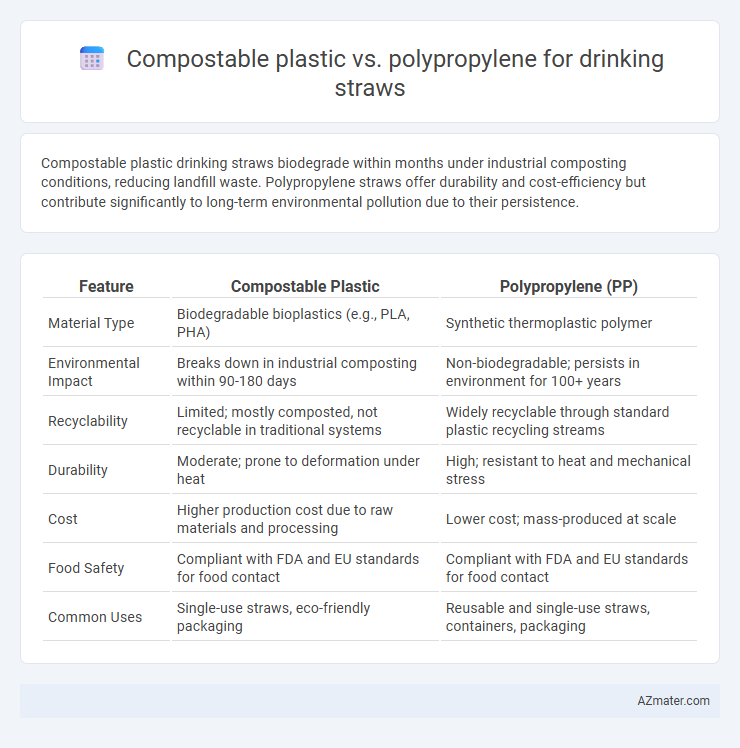Compostable plastic drinking straws biodegrade within months under industrial composting conditions, reducing landfill waste. Polypropylene straws offer durability and cost-efficiency but contribute significantly to long-term environmental pollution due to their persistence.
Table of Comparison
| Feature | Compostable Plastic | Polypropylene (PP) |
|---|---|---|
| Material Type | Biodegradable bioplastics (e.g., PLA, PHA) | Synthetic thermoplastic polymer |
| Environmental Impact | Breaks down in industrial composting within 90-180 days | Non-biodegradable; persists in environment for 100+ years |
| Recyclability | Limited; mostly composted, not recyclable in traditional systems | Widely recyclable through standard plastic recycling streams |
| Durability | Moderate; prone to deformation under heat | High; resistant to heat and mechanical stress |
| Cost | Higher production cost due to raw materials and processing | Lower cost; mass-produced at scale |
| Food Safety | Compliant with FDA and EU standards for food contact | Compliant with FDA and EU standards for food contact |
| Common Uses | Single-use straws, eco-friendly packaging | Reusable and single-use straws, containers, packaging |
Introduction to Drinking Straw Materials
Drinking straws are commonly manufactured from materials like compostable plastics and polypropylene, each offering different environmental impacts and performance characteristics. Compostable plastics, derived from renewable biomass such as cornstarch, break down under industrial composting conditions, reducing plastic pollution. Polypropylene, a durable and lightweight petroleum-based polymer, provides excellent flexibility and cost-effectiveness but poses challenges in biodegradability and long-term environmental persistence.
What Are Compostable Plastics?
Compostable plastics are bioplastics designed to break down into natural elements within a composting environment, typically made from renewable resources like cornstarch or sugarcane. Unlike polypropylene, a petroleum-based plastic, compostable plastics degrade into non-toxic components such as water, carbon dioxide, and biomass under industrial composting conditions in a matter of months. These materials reduce environmental impact by minimizing plastic pollution and contributing to circular waste management systems, making them a sustainable alternative for drinking straws.
Understanding Polypropylene Straws
Polypropylene straws, made from a thermoplastic polymer, are prized for their durability, flexibility, and cost-efficiency in manufacturing. They resist moisture and chemicals, ensuring safety and functionality for single-use drinking applications. However, polypropylene's non-biodegradable nature raises environmental concerns, contrasting sharply with compostable plastic straws designed to break down naturally in industrial composting settings.
Environmental Impact: Compostable Plastic vs Polypropylene
Compostable plastic drinking straws break down naturally within months under industrial composting conditions, significantly reducing long-term environmental pollution compared to polypropylene straws, which can persist for hundreds of years in landfills and marine environments. The production of compostable plastics often relies on renewable resources like cornstarch, lowering carbon footprints and dependence on fossil fuels, whereas polypropylene is derived from petroleum, contributing to higher greenhouse gas emissions. Despite these benefits, compostable plastics require proper disposal systems to achieve effective degradation, while polypropylene straws frequently contribute to plastic pollution due to their widespread improper disposal.
Biodegradability and Compostability Comparison
Compostable plastics used for drinking straws typically break down into non-toxic organic matter within 90 to 180 days under industrial composting conditions, meeting standards such as ASTM D6400 or EN 13432. Polypropylene (PP) straws, while durable and recyclable, do not biodegrade naturally and can persist in the environment for hundreds of years, contributing to plastic pollution. The biodegradability and compostability of compostable plastic straws significantly reduce environmental impact compared to polypropylene counterparts, especially in waste management systems that support composting processes.
Durability and User Experience
Compostable plastic drinking straws typically offer moderate durability, breaking down faster when exposed to moisture and heat, which may impact their usability during extended drinking sessions. Polypropylene straws provide superior strength and resistance to bending or breaking, ensuring a consistent user experience with less risk of straw failure. Users often prefer polypropylene for its reliability, while compostable straws appeal to those prioritizing environmental sustainability despite potential compromises in durability.
Cost Analysis
Compostable plastic drinking straws typically incur higher production costs due to raw materials like polylactic acid (PLA) and specialized manufacturing processes, making them 30-50% more expensive than polypropylene straws. Polypropylene straws benefit from established mass production and lower material costs, averaging around $0.01 to $0.03 per unit, while compostable straws can range from $0.04 to $0.07 per unit. Long-term cost analysis should also factor in environmental regulations and potential waste management savings associated with compostable options.
Manufacturing Processes and Energy Consumption
Compostable plastic straws, typically made from polylactic acid (PLA), are produced through fermentation of renewable biomass like corn starch, requiring energy-intensive processes such as polymerization and extrusion under controlled conditions. Polypropylene straws derive from petroleum refining and polymerization, involving high-temperature and high-pressure techniques with significant fossil fuel consumption. Energy consumption for compostable plastic production often exceeds polypropylene due to bioplastic synthesis complexities, yet lifecycle assessments show potential environmental benefits if end-of-life composting is effectively managed.
Regulatory and Certification Standards
Compostable plastic drinking straws must comply with certifications such as ASTM D6868 and EN 13432, which verify biodegradability and compostability under industrial conditions. Polypropylene straws adhere to FDA 21 CFR 177.1520 for food safety but lack biodegradability certifications. Regulatory frameworks increasingly favor compostable alternatives to reduce plastic pollution, driving demand for certification-aligned eco-friendly straw options.
Which Straw Material Is Best for Sustainability?
Compostable plastic drinking straws, made from plant-based materials like PLA or PHA, break down more quickly in industrial composting facilities, reducing landfill waste and environmental impact compared to polypropylene (PP) straws, which are derived from fossil fuels and persist for centuries as non-biodegradable waste. Polypropylene straws, though durable and widely recyclable, often end up in oceans and ecosystems due to inadequate recycling infrastructure, contributing significantly to plastic pollution and microplastic contamination. For true sustainability, compostable straws aligned with certified composting standards offer a better life-cycle environmental profile by minimizing fossil fuel dependency and enhancing biodegradability.

Infographic: Compostable plastic vs Polypropylene for Drinking straw
 azmater.com
azmater.com